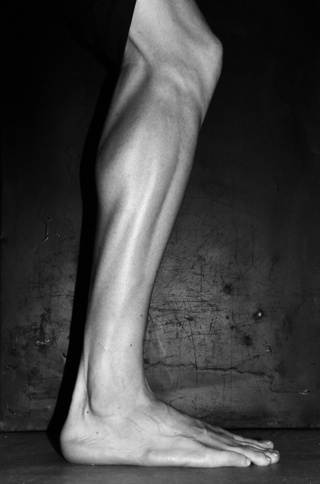
I think my right Achilles (calcaneal) tendon has been sore pretty much since I started running again a few years ago. Well, probably after a while of building up my mileage anyway. It’s nothing too nasty, and often only presents as a scratchy sensation a few cm above the tendon’s insertion into the calcaneal bone, and stiffness in the morning when I get out of bed and walk downstairs. For most of the year I’m training fairly hard, and most of me is so stiff that this feels normal. Do most runners have these Achilles tendon niggles or is it just me?
Probably the most important thing is that it doesn’t get any worse. Secondly, I rarely get any significant pain there. If I do get a sharp pain it feels like I have some adhesion within the tissue, and after the short burst of pain the whole thing softens up and feels great. That’s quite different to the type of short, sharp pain that is followed by more debilitating pain and a refusal of the calf muscles to plantarflex the foot.
I stretch my calves and plantar fascia to limit the tension on the tendon, and more recently have used eccentric exercises (stand on your toes on one leg and lower slowly over the edge of a step, raise again using the other leg to assist, repeat for 10-15 reps and 2-3 sets) to good effect. This was recommended to me by orthopaedic colleagues, and the tendons usually feel much better after the first set alone. This is an exercise that actually gets easier, rather than harder.
After running the tendon is a little tender to poke and squeeze, but feels much happier after icing. It doesn’t like being rubbed against the back of a shoe, which is common. Supportive running shoes are bad for this.
It is very likely that the cause of my Achilles tendon niggles are in my pelvis, or at the very least, are linked to it. The hip flexors of my right hip are tight, as is my quadratus lumborum muscle on that side. This year my gluteus muscles have been tight after running too. My left hip’s abductor muscles are weak, relative to the other side. He-who-looks-after-my-legs has been insightful here, working out where the weak (or tight) links in the (posterior) chain are. So this year I’ve been stretching the muscles of my left hip, and strengthening them in the gym. With the other calf problems I’ve had this year it has been difficult to notice whether this has helped or not, but in preparation for next season this is an area I’m focussing on.
After Bala I quit stretching along with everything else. I’ve only been doing a little running: 3 times a week, 15-25 minutes for fun. Nonetheless my left Achilles tendon started to develop pain low in the posterior heel very near its insertion into the bone. Restarting my stretching and eccentric exercises has helped this tendon return almost to normal. I ran yesterday with no pain or other indicators of soreness on my left side. It’s a little tender to prod, and was stiff this morning but it has definitely improved. N=1.
An observation here would be to tread carefully around the recent trend towards avoiding static stretching. There are good studies that show no change in incidence in injury between two groups of people (e.g. soldiers in boot camp) that stretch or don’t stretch. There is also evidence that faster runners have tighter muscles. Static stretching will reduce the maximum force generation capability of a muscle for a period of time, so it’s probably not a good thing to do before a race or a round of golf (warming up and mild range of movement motions are probably a good idea though). But in many cases stretching of muscles as part of a daily or weekly routine will still help you in preventing and recovering from certain injuries. It may or may not make you run or bike faster. If you are hips were more flexible how would that affect your aero position comfort and power output, and more importantly, your average race velocity?
The trick, as usual is to know yourself. Is your left side tighter than your right, or are you well balanced? You are developing a new pain that may become an injury – why? Is there something you can stretch to help prevent this? Or strengthen? What is the/your normal range of flexibility for that joint? A good physiotherapist or sports therapist can be invaluable in helping you work out what is going on. Stretching is still a useful part of your training regimen.
Links:
A systematic review into the efficacy of static stretching as part of a warm-up for the prevention of exercise-related injury.
Small K, Mc Naughton L, Matthews M.
Res Sports Med. 2008;16(3):213-31.
http://www.ncbi.nlm.nih.gov/m/pubmed/18785063
Stretching to prevent or reduce muscle soreness after exercise.
Herbert RD, de Noronha M, Kamper SJ.
Cochrane Database Syst Rev. 2011 Jul 6;(7):CD004577.
http://www.ncbi.nlm.nih.gov/m/pubmed/21735398
Peak Performance Online, Achilles Tendon: muscle structure and injury rehabilitation.
http://www.pponline.co.uk/encyc/achilles-tendon-muscle-structure-and-injury-rehabilitation-40869
Peak Performance Online, Running Economy: increased joint flexibility may damage your distance running performance.
http://www.pponline.co.uk/encyc/running-economy-increased-joint-flexibility-may-damage-your-distance-running-performance-94
Running Warehouse, Run like a Kenyan.
http://www.runningwarehouse.com/LearningCenter/TrainKenyan.html